Whether you want to contribute a secret recipe or an article to our blog section - we'd love to hear from you! Please feel free to reach out at [email protected] so that we can spread the yummy goodness of saffron recipes together. Join us in our mission to promote sustainable eating habits and share the joy of cooking with everyone!
For now, love yourself and enjoy this one ...
Now love yourself and enjoy this one ...
Indian cuisine gets the low-carb treatment with this Cauliflower Rice Curry recipe—Garam Masala and coconut milk make for a velvet-smooth and spicy dish.

Table of Contents
Cauliflower rice has taken over my recipe collection (i.e., the FFF site)!
You just don’t realize how often you turn to rice as a side dish or as the base for certain cuisines. I would do so reluctantly because, as I became more and more carb-aware, the more I resented serving the white grain to my family who seemed less concerned than I about the carb intake that threatened our very existence!
Okay, maybe I’m being a bit dramatic. But I’m not being dramatic when I say that cauliflower rice has been a game changer. Since discovering it, I have revisited ALL my rice dishes and found that, not only is it a healthy alternative to traditional rice, cauliflower rice is delicious. It’s also easy to make and takes no time to cook.
The latest recipe to get the cauli-makeover is this Indian Curry, which is flavored with garam masala (more on that later), as well as coconut milk, mint, almonds, ginger, and yellow pepper. After making it, the only question you’ll have is whether to serve this as a side so that others can enjoy or have an entire bowl all to yourself!
Is Cauliflower Rice Curry Healthy?
Yes, it’s very healthy. To start, cauliflower rice is a low-carb alternative to traditional white rice. It contains many nutrients, including a wide range of minerals and vitamins, while the rest of the ingredients each have their own health benefits. Even the coconut milk, though calorically dense, contains healthy fats, so it’s good news pretty much across the board. Because the cauliflower rice curry is suitable for vegetarian, vegan, low-carb, keto, paleo, and gluten-free diets, I frequently turn to it when expecting a large number of guests whose individual dietary restrictions may not align.
What is in Garam Masala?
Garam masala isn’t just one thing; in fact, it’s a mixture of things (spices, to be specific). Those without an Indian-English dictionary might be interested to know that “garam masala” translates to “warm spice blend,” which is appropriate given that’s exactly what we get, thanks to the spices to compose it. We’re talking a combination of cinnamon, cardamom, cloves, cumin coriander, black pepper, nutmeg, and bay leaves. If the spice begins with the letter C, there’s a good chance it’s in there. I’ve made up a batch so I always have it on hand. You should do the same so the next time you’re making curry (hey, you’re making one now!), lentils, stews, or roasted vegetables, just sprinkle this mix on near the end of the process to preserve its flavor.
How Should I Make My Cauliflower Rice?
Don’t worry. I’ve got you covered. There are in fact several ways you can make cauliflower rice. It really depends on the tools and small appliances you’ve got at your disposal. The easiest is through the use of a food processor. If you don’t have one, the next best thing is a regular blender. For both methods, be sure to pulse your cauliflower, don’t blend it. If neither appliance is housed in your kitchen, or if you’re making dinner during a power outage, you can either use a regular grater (the kind you’d use for cheese) or grab your favorite chef’s knife and cutting board and get choppin’ until the desired consistency has been achieved. For more on how to make cauliflower rice check out this article out.
INGREDIENTS
- 1 tbsp coconut oil
- 2 cloves garlic, crushed
- 2 tbsp fresh ginger finely grated
- 1 yellow pepper, deseeded and diced
- 1 tbsp garam masala
- 1 tsp ground turmeric
- 1 cup baby spinach
- 2 tbsp almonds, halved
- ½ lime juice
- ½ cup coconut milk
- ½ tsp salt
- 1 small bunch cilantro
- 1 small bunch mint
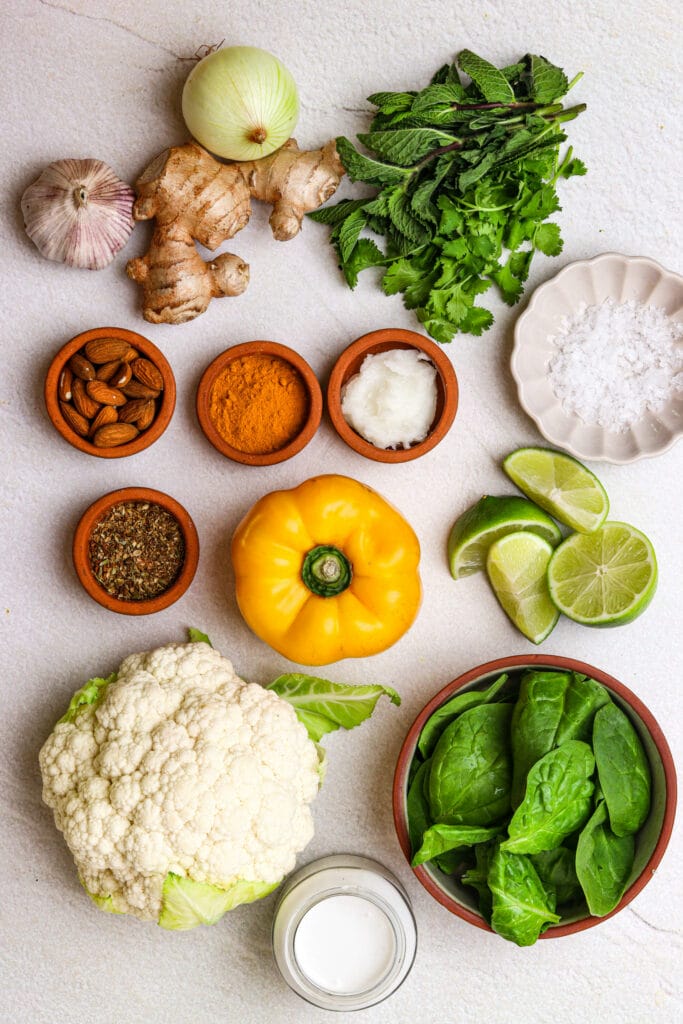
INSTRUCTIONS
Sauté
Melt the coconut oil in a skillet over MED-HIGH heat. Add the onion, garlic, ginger, and the diced peppers. Saute for 5 minutes, until the onion is softened.
Fry
Add the spices, salt, and the cauliflower rice. Fry for 5 minutes.
Simmer
Pour in the coconut milk, squeeze in the lime, and toss in the spinach. Stir then let simmer until most of the liquid has cooked away but it is still creamy.
Garnish
Top with the almonds, cilantro leaves, and the mint.
DEVOUR!
Tips & Tricks to Making a Perfect Cauliflower Rice Curry
- For a satisfying crunch, be sure to dry out your cauliflower rice as much as possible. That residual moisture might make it soggy and you don’t want that.
- When shopping for cauliflower, look for blemish-free florets that are tightly packed. The leaves should be a deep green and not wilting.
- Crush, grate, and deseed your ingredients ahead of time to make life easier come cooking time.
- Want some REALLY creamy? Use cream of coconut instead of coconut milk.
- If time is an issue, I won’t think less of you if you buy pre-riced cauliflower, which should be available at your local grocery store.
- The heat from the yellow pepper comes from the seed and white membrane; leave them intact if you wanna feel the burn.

FAQs
A few things to watch out for: pulse your rice, don’t blend it. Pulsing allows you to keep a closer eye on its consistency. Using a paper towel, press the rice to rid it of excess moisture. Last, consider baking it or frying it on low heat to dry it out and crisp it up.
Following on from the question above, you don’t NEED to bake the rice first. But doing so will dry it out and crisp it up, which may be the consistency you’re going for.
Yep. Buying one head of cauliflower will be cheaper than paying for the convenience of having it done for you. So the question is, what’s more valuable: time or money? Doing the rice yourself should also taste fresher but, given all the spices being added to it, you may not notice a difference.
You could thaw it out, press it, then add it near the end of the cooking process but I recommend sticking with fresh spinach. The taste and consistency would change were you to switch to the frozen variety. Plus, this is one instance where using fresh is actually more convenient than using frozen.
Aside from the almonds, cilantro leaves, and the mint, you could try lime zest, sesame seeds, Greek yogurt, grated coconut, chopped green onions, a drizzle of coconut milk, or even another sprinkle of garam masala. Lots of options.
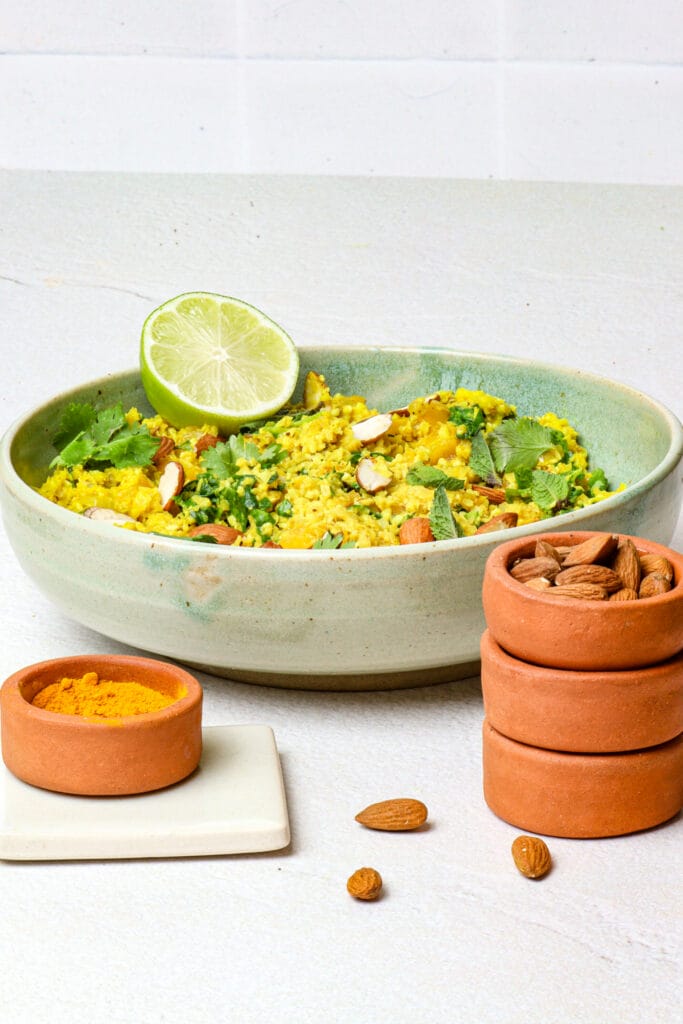
Other Cauliflower Rice Recipes To Try
Mushroom Cauliflower Rice: Fluffy, crispy cauliflower rice with tender mushrooms, kale, and celery for an added crunch.
Herbed Cauliflower Rice: Simple yet elegant, this low-carb rice alternative blends vivacious herbs and sweet pomegranate.
Green Cauliflower Rice: Eat your greens despite using a white vegetable by mixing jalapeno, green onions, and cilantro.
Mexican Cauliflower Rice: A perfect side (or ingredient in your tacos) for Mexi Night! A low-carb dish with a spicy kick.
How To Store Cauliflower Rice Curry
Let the cauliflower rice curry cool completely then store it in an airtight container in the fridge for up to 3 days. Letting it cool is an important step; storing it while still warm will create steam inside the container and turn your rice to mush. To reheat, you can either warm it in the microwave or on the stove. You might find the taste has diminished in the interim, so have some lime juice or spices on hand and add at will. You can also freeze cauliflower rice in an airtight container for up to 3 months. Just let it thaw in the fridge overnight then warm it up as described above.
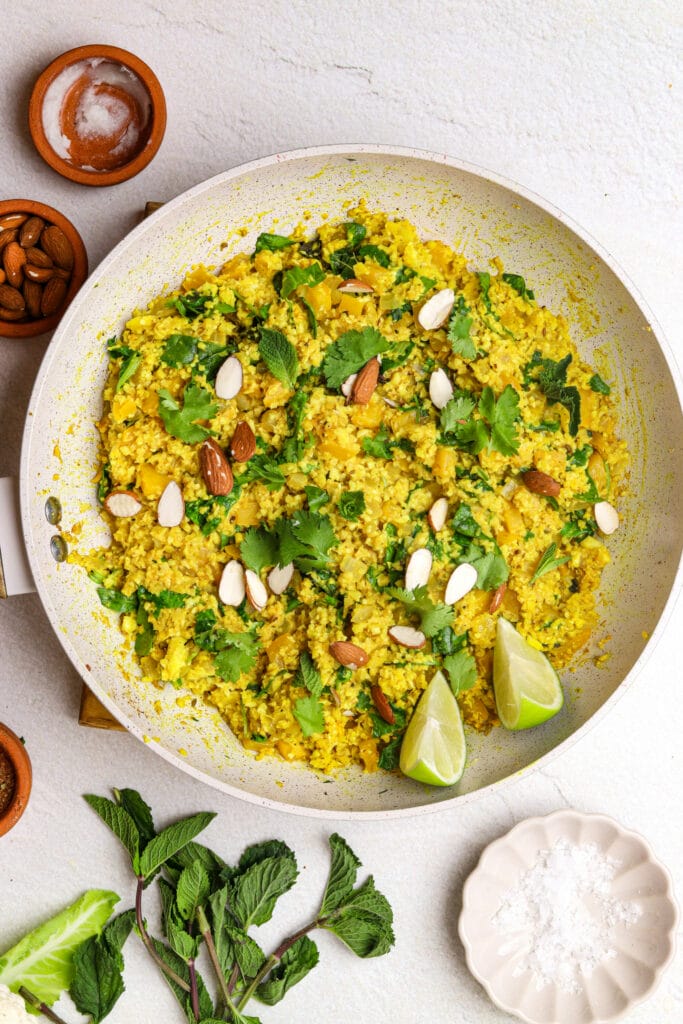
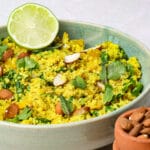
Cauliflower Rice Curry
Ingredients
- 1 tbsp coconut oil
- 2 cloves garlic crushed
- 2 tbsp fresh ginger finely grated
- 1 yellow pepper deseeded and diced
- 1 tbsp garam masala
- 1 tsp ground turmeric
- 1 cup baby spinach
- 2 tbsp almonds halved
- ½ lime juice
- ½ cup coconut milk
- ½ tsp salt
- 1 bunch cilantro
- 1 bunch mint
Instructions
- Melt the coconut oil in a skillet over MED-HIGH heat. Add the onion, garlic, ginger, and the diced peppers. Saute for 5 minutes, until the onion is softened.
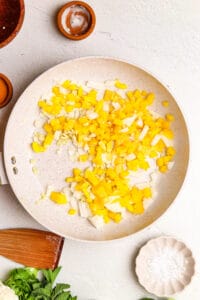
- Add the spices, salt, and the cauliflower rice. Fry for 5 minutes.
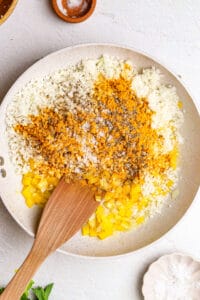
- Pour in the coconut milk, squeeze in the lime, and toss in the spinach. Stir then let simmer until most of the liquid has cooked away but it is still creamy.
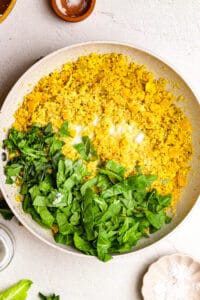
- Top with the almonds, cilantro leaves, and the mint.

Notes
- When shopping for cauliflower, look for blemish-free florets that are tightly packed. The leaves should be a deep green and not wilting.
- Crush, grate, and deseed your ingredients ahead of time to make life easier come cooking time.
- Want some REALLY creamy? Use cream of coconut instead of coconut milk.
Nutrition

The post Cauliflower Rice Curry appeared first on Food Faith Fitness.
References:
By: FoodfaithfitnessTitle: Cauliflower Rice Curry
Sourced From: www.foodfaithfitness.com/cauliflower-rice-curry/
Published Date: Mon, 26 Feb 2024 22:48:24 +0000
Frequently Asked Questions
How do you make medicinal herbs?
There are many different methods to make herbs into medicinal products. The most common method is to dry the herbs in a warm, dark location before grinding them into a powder or extracting their essential oils. This can be accomplished by hanging herbs upside down in bunches, laying herbs on a drying screen, or using a food dehydrator.
Once dried and ground, herbs can be stored in airtight containers for future use. Other herbs may require special preparation, such as infusing herbs into oil or vinegar, making tinctures with alcohol, or distilling herbs to create essential oils.
Learning the correct techniques for preparing herbs can help ensure that they retain their medicinal properties and potency for optimal health benefits. Using fresh herbs is usually best, but herbs can also be grown in a pot or garden and harvested when they are mature. Herbs can be purchased at health food stores, online retailers, and specialty shops.
No matter where herbs come from, the preparation techniques remain the same; drying herbs in a warm location followed by grinding or extracting the essential oils. You can make your medicinal herbs with the right herbs and preparation techniques.
When making herbal preparations, it is essential to remember that herbs can vary in potency, so always dilute herbs before use or follow the directions on any product label. Additionally, herbs are best used fresh, as many of their beneficial components degrade over time.
Following safety guidelines and paying attention to the potency of herbs can help ensure that you get the most benefit from your herbs. With a bit of practice and preparation, anyone can make therapeutic herbs with medicinal properties. Remember that herbs should never replace any medical advice or treatments prescribed by a doctor. Always consult a licensed healthcare professional before using herbs medicinally.
What is the difference between herbs and spices?
Herbs are used for cooking, and spices are used for seasoning.
Herbs have more intense flavors and can be used to cook dishes, while spices can bring out the flavor of foods without altering the taste.
Spices can also be added to food during preparation, such as curry. Spices may be bought individually, or whole packages may be purchased. There are many spices, including black pepper, cayenne pepper, cinnamon, cloves, coriander, garlic, ginger, nutmeg, oregano, paprika, parsley, rosemary, sage, salt, thyme, turmeric, vanilla extract, etc.
The best way to ensure that you are selecting the right spice for your dish is to read the label carefully. If there is an ingredient list, look for "spice" among the ingredients. A common mistake cooks make is buying too much of a particular spice because they do not realize how little they need.
There are a few basic rules to follow when choosing which herb or spice to use. For example, most herbs are fresh, whereas spices tend to last longer. Also, herbs are generally found in small quantities, while spices come in larger containers. Finally, most herbs are usually sold loose (or ground), while spices are packaged in jars or cans.
As long as you are careful to select the correct herbs or spices, you will find that adding them to recipes makes preparing meals easier. After all, spices add flavor to various dishes, while herbs can help improve the appearance and aroma of food.
What herb heals all wounds?
The answer to this question varies depending on the type and severity of the wound.
The herb comfrey (also known as knitbone) has long been used for its healing properties, particularly for skin injuries such as cuts and bruises.
Studies suggest that comfrey contains allantoin, which helps speed up healing. Other herbs commonly used for healing wounds include calendula, plantain, and yarrow. These herbs help to reduce inflammation, stop bleeding and speed up the skin's healing process.
In addition to herbs, honey has also been found to have powerful antimicrobial properties that can help prevent wound infection.
Herbs for wound care is an age-old practice that continues to be used today. However, herbs should not replace medical treatment, and always consult your doctor before using herbs for healing. With the right herbs, you can give your body the support it needs to heal naturally.
Which spices from the kitchen are used to cure diseases?
There are more than 4000 medicinal plants that are widely distributed throughout the world. Some of these plants contain active compounds that may help treat various ailments.
In India alone, there are more than 1000 species of herbs that are used for medical purposes. This includes Ayurvedic medicine, Unani medicine, Siddha medicine, Homeopathic medicine, and Chinese medicine.
The most common ingredient found in these medicines is ginger. Ginger contains volatile oils that give it its aromatic flavor. These oils contain anti-inflammatory properties that make them useful against arthritis, fever, vomiting, and indigestion.
Ginger also helps relieve nausea and stomach cramps caused due to pregnancy. Pregnant women often consume ginger tea to reduce morning sickness. Ginger is also commonly used for cough and cold relief.
Another spice that is known to have medicinal value is turmeric. Turmeric contains curcumin which has been shown to inhibit tumor growth. This makes it an effective cancer treatment.
Turmeric is also considered to be very beneficial for joint health. It relieves inflammation and stiffness associated with rheumatoid arthritis. It is also believed to prevent osteoporosis.
Garlic, too, is another herb that is extensively used in traditional medicine. Its healing qualities include treating infections, asthma, heart disease, and diabetes and even reducing cholesterol levels. Garlic oil is also used to treat wounds and insect bites.
Garlic is a natural antibiotic that fights bacteria and viruses. The antibacterial property makes it ideal for treating respiratory tract infections such as bronchitis and pneumonia.
It is also helpful in preventing urinary tract infections.
Other spices like cinnamon, cloves, nutmeg, cardamom, black pepper, ginger, cayenne, mustard seeds, fennel, and coriander are also used to treat different illnesses.
What herbs should you take daily?
Depending on your health and wellness needs, many herbs can be taken daily to help improve your overall health.
Popular herbs for daily consumption include ashwagandha, turmeric, ginger, holy basil, chamomile, lavender, peppermint, and cayenne pepper. Ashwagandha is an adaptogenic herb that can help the body resist stress and anxiety. Turmeric is known for its anti-inflammatory properties, while ginger has been shown to aid digestion and boost immunity. Holy basil may help with managing blood sugar levels, as well as providing a calming effect. Chamomile can promote relaxation, while lavender is used in aromatherapy for its calming properties. Peppermint can help aid digestion and reduce nausea, while cayenne pepper has antibacterial properties that may boost your immunity.
As always, you must consult your doctor before taking herbs daily to ensure they are safe for you and do not interact with any other medications or herbs you may be taking.
There is no shortage of information on what foods we should eat and how much exercise we should do. But when it comes to what supplements we should take, there is a dearth of knowledge.
This is because most of us aren’t sure which ones work or which are junk. So we go online and look up whatever we can find.
But often, these articles are written by companies trying to promote their products. Which means they're usually biased toward their product.
So instead of finding unbiased advice, we end up reading marketing hype.
This makes sense since marketers make more money selling stuff than doctors.
The medical industry isn’t even allowed to advertise directly to consumers anymore. The best way to learn about natural remedies is to read independent reviews.
This is where you'll find real users sharing their experiences with each supplement. These sites give you an honest opinion of whether or not a particular herb helps.
Users will often share their experience with a supplement after taking it. This gives you a good idea of its effectiveness and any side effects.
You can also check out forums dedicated to herbalism. Here you can ask questions and receive answers based on personal experience.
Of course, there are plenty of other ways to learn about herbs.
There are books, websites, blogs, videos, podcasts, and classes. All of them provide valuable information about natural remedies.
What spice is good for inflammation?
Turmeric is one spice that can be beneficial for reducing inflammation. It contains the active ingredient curcumin, which has been studied extensively and shown to have anti-inflammatory effects on the body. Other spices like ginger, cinnamon, cayenne pepper, garlic, and cardamom may also reduce inflammation in the body. Adding these spices to your diet can help reduce inflammation and promote overall health.
Another spice that can be used to reduce inflammation is black pepper. The active ingredient in black pepper, piperine, has been studied and found to have anti-inflammatory properties. It may also help reduce pain associated with inflammation. Additionally, the spice contains antioxidants which are beneficial for overall health.
Adding black pepper to your diet may help reduce inflammation and promote overall health. Be sure to talk with your doctor before adding any spice to your diet, as some spices may interact with your medications or supplements. Eating various healthy foods, including spices with anti-inflammatory benefits, can help keep your body balanced and reduce the risk of chronic inflammation-related illnesses.
In summary, adding spices to your diet can be beneficial for reducing inflammation and promoting overall health. Spices like turmeric, ginger, cinnamon, cayenne pepper, garlic, cardamom, and black pepper have all been studied for their potential anti-inflammatory effects.
Statistics
- For those with high cholesterol, garlic supplementation appears to reduce total and/or LDL cholesterol by about 10-15% (72Trusted Source73Trusted (healthline.com)
- Studies have shown that cinnamon can lower fasting blood sugars by 10-29% in diabetic patients, which is a significant amount (9Trusted Source10Trusted (healthline.com)
External Links
[TAG54]
[TAG56]
[TAG58]
[TAG61]
How To
How To Upcycle Herbs After Making Infusions, Oils, Tinctures, And More?
There are more ways to use herbs than you might realize. This is why it's essential to keep an open mind when learning how to make herbal infusions, oils, tinctures, and more.
You'll find that there are many methods for making these products, and even though they may seem similar, each method has its benefits.
For example, some methods include creating decoctions, boiling water or alcohol with the herb(s), and letting them simmer for a while. These infusions are solid and potent because they contain higher concentrations of active compounds.
Another type of infusion includes macerating the herb(s), which means soaking them in liquid for a few hours or even overnight. Macerations tend to produce milder results because the plant material isn't boiled.
Some cold-infused forms involve steeping herbs in cool liquids such as ice cubes or cold water. Cold infusions are gentler than hot ones, often used to treat minor ailments.
Herbal oil extraction involves heating the herb(s) to release the essential oils. You can either do this yourself or have someone help you out with it.
Finally, there are tinctures made by mixing herbs with alcohol. They're usually taken orally and are very effective for treating coughs, colds, and flu symptoms.
The best way to learn how to create infused products is to experiment with various techniques. Each technique offers a different potency and effectiveness, depending on the herb(s) you choose.
Once you've tried a few different methods, you'll begin to develop your preferences. In time, you'll be able to determine which techniques work well for you and which aren't worth pursuing.
 |
[TAG63]Hello hello! Just wanted to pop in with a cute little life update. ♡ I’m delighted to share that our sweet son, Milo Alexander Martin, came to join our family |
 |
[TAG64]This vibrant lemony broccoli pesto pasta is quick and easy to make and full of fresh flavors. Your veggies, greens, and pasta…all in one gorgeous dish! ♡ We’re |
 |
[TAG65]This simple roasted carrot soup recipe is made with creamy tahini and topped with crispy za’atar chickpeas. Naturally gluten-free, vegetarian and vegan. If you |
 |
[TAG66]My longtime favorite flourless cake recipe is decadently rich and delicious, naturally gluten-free, and easy to make in under 1 hour! Trust me, this flourless |
 |
[TAG67]Easy to make full flavoured recipes. Life is too short for boring food! |
 |
[TAG68]This vegetarian cabbage roll soup is filled with protein-rich lentils and all of the delicious flavors you love from traditional cabbage rolls. Naturally |
 |
[TAG69]These zesty roasted sweet potato and chickpea bowls are layered with sautéed spinach and brown rice and tossed with my favorite 4-ingredient chipotle tahini |
 |
[TAG70]This classic matcha latte recipe is easy to make and customize to your liking and always so delicious. The older I get, the more I’m convinced that one of |
 |
[TAG71]This veggie-loaded broccoli cheese soup recipe is perfectly velvety and creamy without using heavy cream. Instant Pot, Crock-Pot and stovetop options all |
 |
[TAG72]HEALTHY & KID-FRIENDLY MEALS easy dinner recipes made in minutes. The Latest Recipes st. Patrick's Day Recipes Hello! I'm Sara! Welcome to Dinner at the Zoo! |
 |
[TAG73]This winter farro salad recipe is made with the most delicious blend of seasonal fruit, greens, nuts, crumbled cheese and tossed with a vibrant orange ginger |
 |
[TAG74]This lovely white wine sautéed mushrooms recipe is quick and easy to make, full of rich savory flavors, and can pair well as a side dish with many different |
 |
[TAG75]This traditional Swedish meatballs recipe is bursting with rich, savory flavors and topped with a creamy gravy. Always so comforting served over mashed |
 |
[TAG76]This classic Irish coffee recipe is easy to make with 4 ingredients in just a few minutes. Always so warm and cozy! Let’s warm up with a hot mug of Irish |
 |
[TAG77]From comfort foods to indulgent dishes browse hundreds of recipes that your family will love and make over and over again. Cooking Classy has never been easier, |
 |
[TAG78]This snickerdoodle blondies recipe is irresistibly rich, buttery, tangy, and sprinkled with a crunchy cinnamon-sugar topping. Yes, they’re just as good as you |
 |
[TAG79]This creamy garlic mushroom orzo pasta recipe is easy to make and always so comforting and delicious. Say hello to one of my favorite back-pocket recipes |
 |
[TAG80]This 3-ingredient homemade dog treats recipe is quick and easy to make and cut into whatever shapes you love. This holiday cookie season, we can’t forget about |
 |
[TAG81]"Food Wars" hosts Harry Kersh and Joe Avella travel across NYC to find the best Bodega sandwich in the city. They'll be visiting four different locations in |
 |
[TAG82]A family food blog with hundreds of simple, tested and approved recipes. Find easy step-by-step photo cooking instructions and video recipes. |
 |
[TAG83]🇮🇩 Street Food in Bali: 👕 T-shirts: 🌶 Ghost Chili: SURABAYA, INDONESIA: Welcome to Surabaya, the second biggest city in Indonesia, and an |
 |
[TAG84]This cake is based on the chocolate sheet cake recipe Ree made for years and years, originally given to her by her mother-in-law, Nan Drummond. Nan gave Ree |
 |
[TAG85]Hello friends..! In this video we both brothers are going to Try Spiciest Food From Zomato. In our upcoming vlogs we are gonna do lots of different food |
 |
[TAG86]#shorts #food #fastfood #mcdonalds #tacobell |
 |
[TAG87]find out hundres of delicous food recipes |
 |
[TAG88]There are just too many delicious foods in Cloudy With A Chance Of Meatballs to only do 1 video so we are back with Try Not To Eat Cloudy With A Chance Of |
 |
[TAG89]Today, I Zhong, am going to eat 100 years of foods. First we start in the 1900’s with Hershey kisses. Then we try a peanut butter and jelly sandwich. Next we |
 |
[TAG90]Can you cook steak with a flamethrower? Cook eggs in the microwave? We've tested 100 of the most viral food hacks to give you answers. SUBSCRIBE TO CATCH |
 |
[TAG91]Weird History Food is getting into some Misconceptions Around Popular Foods. We all know how to eat, and most of us know how to cook, at least on some basic |
 |
[TAG92]The food blog with mostly healthy recipes made with real, whole foods inspiring more people to get into the kitchen and cook something good. |
 |
[TAG93]Jeff Mauro's Coconut Shrimp Salad is perfect for a light weeknight dinner, but it tastes just like vacation 🍤🌴 #FoodNetwork #JeffMauro #CoconutShrimp |
 |
[TAG94]This kimchi beef noodle soup recipe is made with your choice of noodles, veggies, and a richly seasoned sesame kimchi broth. Stovetop, Instant Pot and |
 |
[TAG95]Hot buttered rum is the perfect cozy cocktail to warm you up on a winter’s night and perfect for easy entertaining. Another warm cocktail recipe that needs to |
 |
[TAG96]This gingerbread cake recipe is easy to make, perfectly moist and fluffy, and made with a delicious blend of molasses and warming spices. This is one of those |
 |
[TAG97]A food blog with hundreds of quick and easy dinner recipes. Classics done right, incredible one pot recipes, Asian takeout at home and holiday feasting! |
 |
[TAG98]These espresso chocolate chip cookies are made with a soft and chewy espresso-vanilla dough, melty chocolate chips and a sprinkling of flaky sea salt. |
Did you miss our previous article...
https://belovedsaffron.com/recipes/sour-cream-banana-bread-recipe
.png)





